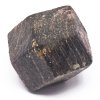The garnet group includes a group of minerals that have been used since the Bronze Age as gemstones and abrasives. The name “garnet” comes from 14th century Middle English word gernet meaning ‘dark red’, from the Latin granatus granatus coming from granum (grain , seed) + suffix “atus” , possibly a reference to “mela granatum” or even “pomum granatum”, a plant whose abundant vivid red arils contained in the fruit are similar in shape, size, and color to some garnet crystals.
Six common species of garnet are recognized by their chemical composition. They are pyrope, almandine, spessartine, grossular (varieties of which are hessonite or cinnamon-stone and tsavorite), uvarovite and andradite. The garnets make up two solid solution series: pyrope-almandine-spessarite and uvarovite-grossular-andradite.
Source: en.wikipedia.org/wiki/Garnet





























Leave a Reply
You must be logged in to post a comment.